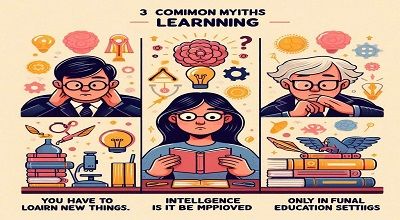3 Common Myths About Learning
Now here, What are 3 Common Myths About Learning? There are many myths and misconceptions about learning that can affect how we study, teach, and perform. Some of these myths are based on personal preferences, intuition, or anecdotal evidence, but they are not supported by scientific research.
Here are three common myths about learning and what the evidence says instead:
Myth 1: Every student has a ‘learning style’. This myth suggests that students have a preferred way of learning, such as visual, auditory, or kinesthetic, and that they learn better when the instruction matches their style. However, there is no good evidence that learning styles exist or that matching instruction to students’ preferences improves their learning. Evidence-based concept: Instead of focusing on learning styles, teachers and students should use multiple and varied ways of processing information, such as words, images, sounds, and actions. This helps create richer and more durable memories that can be retrieved and applied in different situations.
Myth 2: I only need one good method for studying. This myth implies that there is a single best way to study for any subject or task and that once you find it, you can stick to it. However, research shows that using different strategies and techniques for studying can enhance your learning and make it more flexible². Evidence-based concept: Instead of relying on one method, such as rereading or highlighting, students should use a variety of effective strategies, such as self-testing, spacing, interleaving, elaboration, and retrieval practice. These strategies help students monitor their understanding, review the material in different ways and contexts, and connect new information to prior knowledge.
Myth 3: If it’s easy, I must be learning. This myth assumes that learning is best when it feels effortless and comfortable. However, research shows that learning is often more effective when it involves desirable difficulties, such as challenging tasks, feedback, errors, and struggles. These difficulties make students pay more attention, process the information more deeply, and transfer their skills to new situations. Evidence-based concept: Instead of avoiding difficulties, students should embrace them as opportunities for growth and improvement. Students should seek out challenging tasks that are within their reach but require effort and persistence. They should also seek out feedback from others and learn from their mistakes.
There are several myths and misconceptions about learning. Here are three common ones:
Learning is a One-Size-Fits-All Process:
This myth assumes that all individuals learn in the same way and at the same pace. In reality, people have diverse learning styles and preferences. Some may learn best through visual aids, while others prefer hands-on experiences or auditory methods. Recognizing these differences and tailoring educational approaches accordingly can be more effective.
Learning Only Happens in the Classroom:
Learning is not confined to formal educational settings. While schools and classrooms play a significant role, learning can occur anywhere and at any time. Informal learning through experiences, self-study, and interactions with others can be just as valuable, if not more so, than structured classroom learning.
Learning Stops After Formal Education:
Another common myth is the belief that once a person completes their formal education, their learning journey is over. In reality, learning is a lifelong process. People continue to acquire new knowledge and skills throughout their lives, both personally and professionally. Continuous learning is essential in a rapidly changing world.
Recognizing and debunking these myths can lead to more effective and adaptable approaches to education and personal development.
What is the best way to study?
- There is no single best way to study, as different strategies may work better for different subjects, tasks, and learners. However, some general principles that can help you study more effectively are:
- Use active learning techniques, such as self-testing, summarizing, explaining, and teaching. These techniques help you check your understanding, identify gaps in your knowledge, and consolidate your memory.
- Space out your study sessions over time, rather than cramming them all at once. This helps you retain the information for longer and avoid forgetting.
- Interleave different topics or types of problems, rather than focusing on one at a time. This helps you make connections between different concepts and apply them to new situations.
- Elaborate on the material by relating it to your own experiences, interests, and goals. This helps you make the information more meaningful and memorable.
- Use retrieval practice to recall the information from memory, rather than just looking at it. This helps you strengthen your memory traces and improve your recall.
Summary
These are some of the evidence-based strategies that can help you study more effectively. You can also try to find out what works best for you by experimenting with different methods and monitoring your progress. The most important thing is to be consistent and motivated in your learning.
